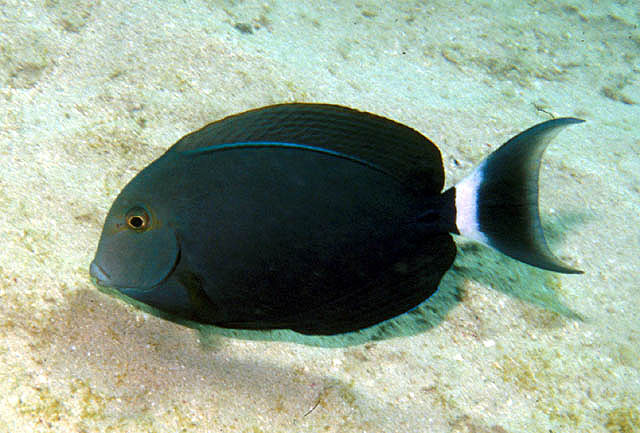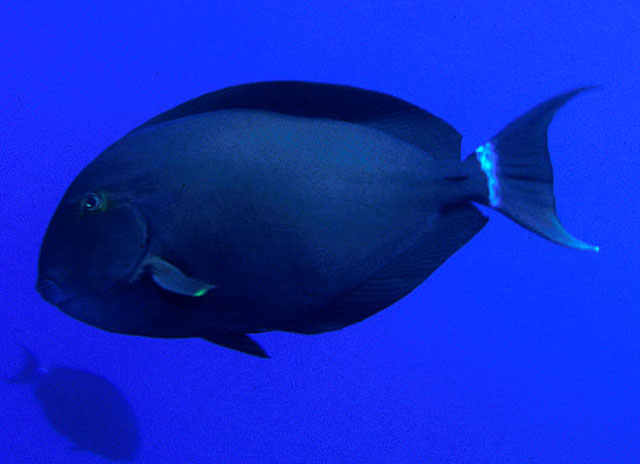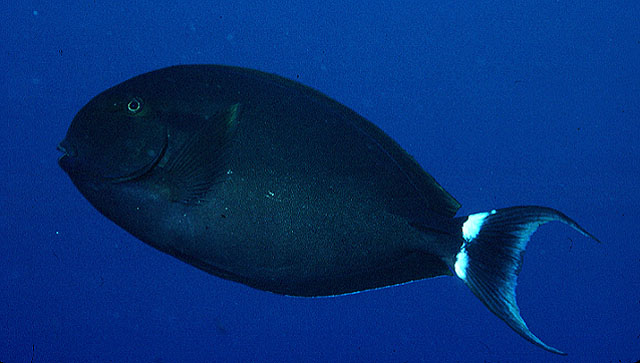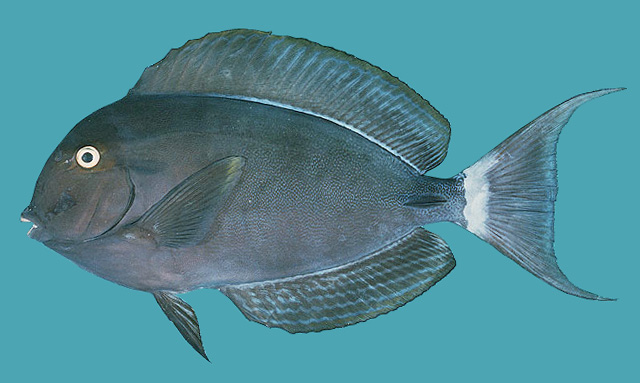Acanthurus
gahhm
(Forsskål,
1775)
Black surgeonfish
View all media / Upload your photos and videos
Expand all
Classification / Names
Teleostei (teleosts) > Acanthuriformes (Surgeonfishes) >
Acanthuridae (Surgeonfishes, tangs, unicornfishes)
> Acanthurinae
Etymology: Acanthurus: Greek, akantha = thorn + Greek, oura = tail (Ref. 45335).
More on author:
Forsskål.
Environment / milieu / depth range / climate zone / distribution range
Distribution
Western Indian Ocean: endemic to the Red Sea and the Gulf of Aden.
Maps

Acanthurus gahhm / Native range
AquaMaps Data sources:
GBIF
OBIS
This map was computer-generated and has not yet been reviewed.

Acanthurus gahhm / Suitable habitat
AquaMaps Data sources:
GBIF
OBIS
This map was computer-generated and has not yet been reviewed.

Acanthurus gahhm / Point map
AquaMaps Data sources:
GBIF
OBIS
This map was computer-generated and has not yet been reviewed.

Acanthurus gahhm / Year 2050
AquaMaps Data sources:
GBIF
OBIS
This map was computer-generated and has not yet been reviewed.
Size / Weight / Age
Max length: 40.0 cm TL male/unsexed (Ref. 30573).
Short description
Dorsal spines (total): 9; Dorsal soft rays (total): 24 - 28; Anal spines: 3; Anal soft rays: 23 - 26. Characterized by having 2 longitudinal bands on the side, one from the hind margin of the eye posteriorly, another from the groove around the caudal peduncle spine anteriorly. Juveniles of less than 5 cm SL lack the anterior band; less than 10 cm SL lack the posterior band. Reaches 24 cm SL.
Biology
Main reference
Randall, J.E. 1987 Three nomenclatorial changes in Indo-Pacific surgeonfishes (Acanthurinae). Pac. Sci. 41(1-4):54-61. (Ref. 1921)
IUCN Red List Status (Ref. 125652)
Least Concern (LC); date assessed: May 04 2010
CITES (Ref. 131153)
Not Evaluated
CMS (Ref. 116361)
Not Evaluated
Threat to humans
Harmless
More information
- Countries
- FAO areas
- Ecosystems
- Occurrences
- Introductions
- Stocks
- Ecology
- Diet
- Food items
- Food consumption
- Ration
- Common names
- Synonyms
- Metabolism
- Predators
- Ecotoxicology
- Reproduction
- Maturity
- Spawning
- Spawning aggregation
- Fecundity
- Eggs
- Egg development
- Age/Size
- Growth
- Length-weight
- Length-length
- Length-frequencies
- Morphometrics
- Morphology
- Larvae
- Larval dynamics
- Recruitment
- Abundance
- References
- Aquaculture
- Aquaculture profile
- Strains
- Genetics
- Allele frequencies
- Heritability
- Diseases
- Processing
- Mass conversion
- Vision
- Pictures
- Stamps, Coins Misc.
- Sounds
- Ciguatera
- Speed
- Swim. type
- Gill area
- Otoliths
- Brains
Estimates based on models
Preferred temperature (Ref. 123201): 23.8 - 29.1, mean 28.6 °C (based on 42 cells).
Phylogenetic diversity index (Ref. 82804): PD50 = 0.5 [Uniqueness, from 0.5 = low to 2.0 = high].
Bayesian length-weight: a=0.02344 (0.01118 - 0.04914), b=2.95 (2.78 - 3.12), in cm total length, based on LWR estimates for this Genus-body shape (Ref. 93245).
Trophic level (Ref. 69278): 2.8 ±0.3 se; Based on food items.
Resilience (Ref. 120179): Medium, minimum population doubling time 1.4 - 4.4 years (Preliminary K or Fecundity.).
Fishing vulnerability (Ref. 59153): Low to moderate vulnerability (30 of 100).
Price category (Ref. 80766): Medium; Very questionable: based on ex-vessel price for species in this family.
Nutrients (Ref. 124155): Calcium = 49.2 [20.3, 132.8] mg/100g; Iron = 0.656 [0.252, 1.578] mg/100g; Protein = 18.5 [17.3, 19.6] %; Omega3 = 0.108 [0.051, 0.227] g/100g; Selenium = 17.6 [6.4, 50.3] μg/100g; VitaminA = 43.6 [12.4, 142.8] μg/100g; Zinc = 2.24 [0.71, 4.02] mg/100g (wet weight);




